How Can We Help?
Training mode
This chapter will provide a detailed overview of the user interface and numerous features of DataMesh One in training mode. You’ll learn how to use DataMesh One in training mode, including the processes to design learning and test tasks by instructors, as well as the procedures followed by students to complete these learning and test tasks.
Note: When opening courseware created with DataMesh Studio (v7.4.1 or later), it is recommended to use the corresponding version of DataMesh One. Using an older version of DataMesh One (v7.4.1 or earlier) to open courseware created with the newer version may cause compatibility issues due to updates in question structures, which could result in some content not displaying correctly.
Learning and exam interface for the learner
Training group list
The main page of the Learning and Exam tab displays a list of training groups that the user needs to participate in for learning and exams.
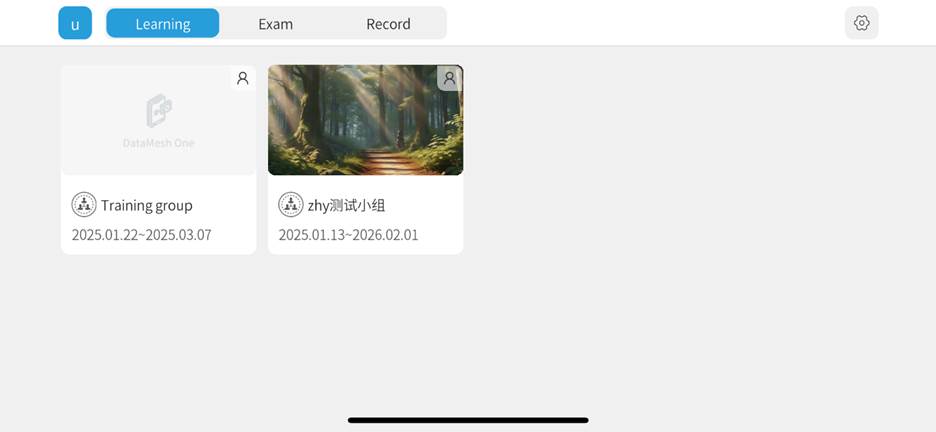
Courseware list
The Courseware List page displays all the courseware that users need to study or take exams for within a training group.
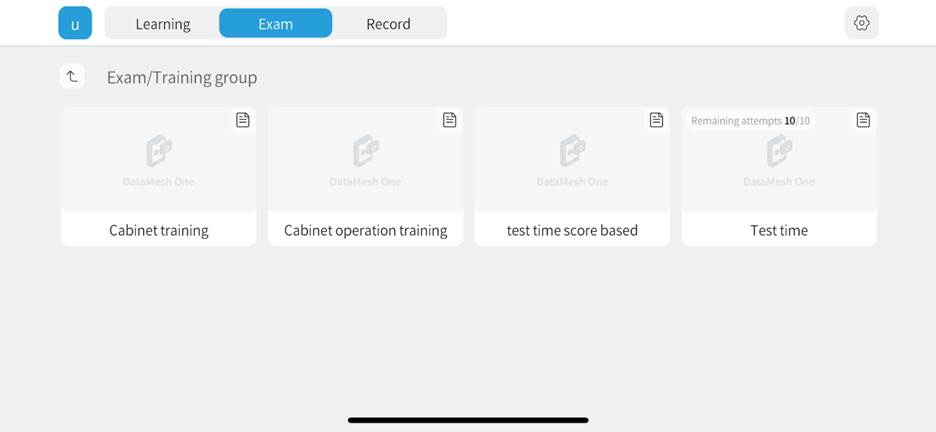
In the exam courseware list, if the courseware limits the number of attempts, the remaining and total number of exam attempts will be shown in the format “Remaining Attempts/Total Attempts.”
Question interface
The answering interface is divided into four types based on the question format: Content Viewing Questions, Single-Choice Questions, Multiple-Choice Questions, and Hands-on Questions. The interface layout varies between Learning Mode and Exam Mode.
| Display Item | Learning Mode | Exam Mode | Question Type | Description |
| Question List | √ | × | All | Click on the question number or status in the question list to navigate to the corresponding question and retry answering. |
| Confirm | √ | √ | All | After confirming your answer, proceed to the next question. |
| Skip | × | √ | All | Once a question is skipped, you cannot return to it. The system automatically marks it as incorrect and assigns the minimum score. |
| Demo | √ | × | Hands-On Questions | Demonstrate the correct interaction method for completing the task. |
| Reset | √ | √ | Hands-On Questions | Resets all interactive operations to their initial state. |
Content viewing questions
The content viewing question interface includes the question, subtitles, model animations, actions, camera movements, special effects, and other content. Users can flip through pages, watch the related content, and learn and master the relevant knowledge. After meeting the required time, users can proceed to answer the question.
Learning

Exam
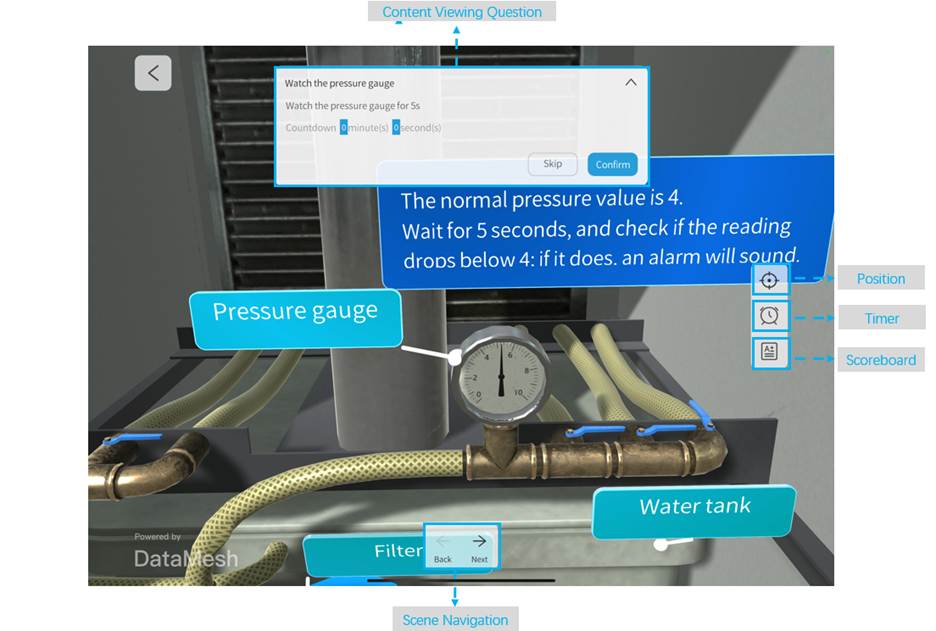
Answering operations are as follows:
- Confirm: After the countdown ends, click the Confirm button to complete the content viewing question.
- Skip(Exam): Click the Skip button to bypass the current question and automatically proceed to the next one. Skipped questions cannot be revisited and will be marked as incorrect。
- Scene navigation:
- If set to On click, users can use the scene navigation arrows to move between scenes.
- If set to Autoplay after X seconds, the system will automatically navigate after the waiting period, or users can manually navigate by clicking the scene navigation arrows.
- If set to Navigate via button or link, the scene navigation arrows will disappear, and users can only navigate by clicking the corresponding interactive object (button or model).
Single-choice questions
In a single-choice question, only one option can be selected, and each option may have a different score. Single-Choice Questions are divided into two types: Standard Single-Choice Questions and Navigation-Based Single-Choice Questions.
Standard Single-Choice Questions
In standard single-choice questions, all options are displayed directly on the question panel. Users select an option to answer. The question panel includes the title, question content, and options, and users can browse the course content to assist in understanding the question and making a selection.
Learning
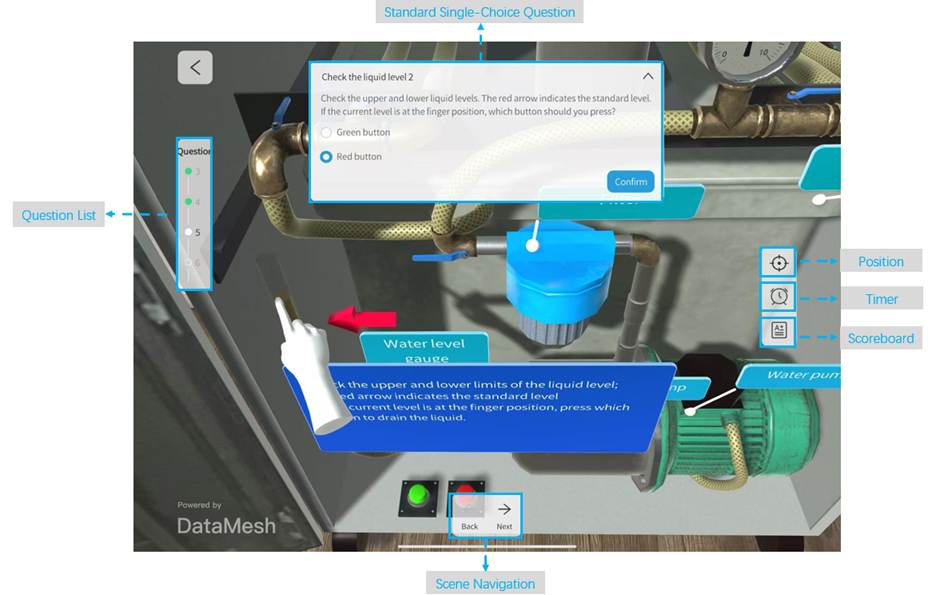
Exam
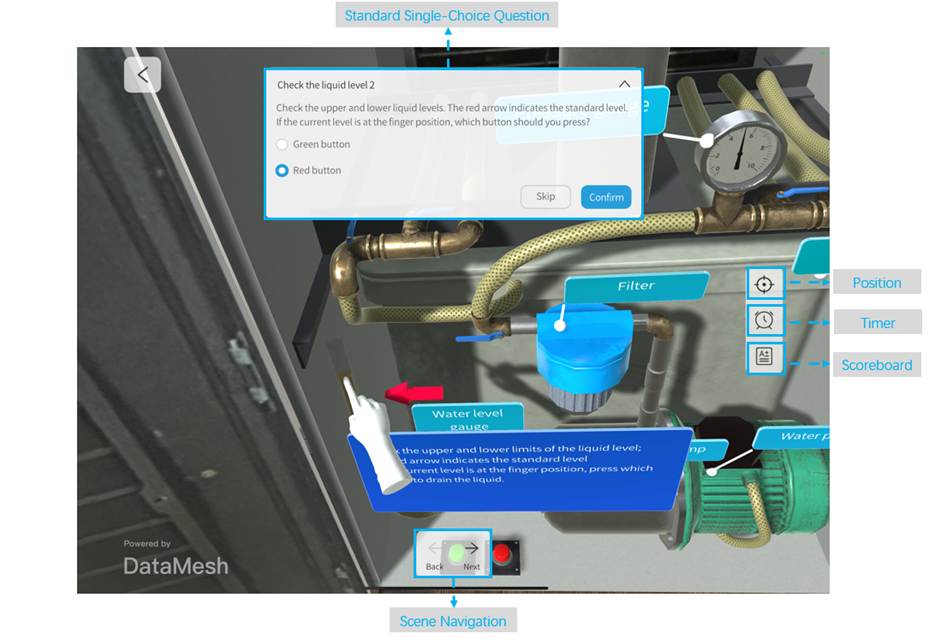
Answering operations are as follows:
- Confirm: After selecting an option, click the Confirm button. The system will score the answer based on the selected option’s points, and the score will be displayed in the lower-right corner.
- Skip(Exam): Click the Skip button to bypass the current question and automatically proceed to the next one. Skipped questions cannot be revisited and will be marked as incorrect, scoring the minimum possible points.
- Scene navigation:
- If set to On click, users can use the scene navigation arrows to move between scenes.
- If set to Autoplay after X seconds, the system will automatically navigate after the waiting period, or users can manually navigate by clicking the scene navigation arrows.
- If set to Navigate via button or link, the scene navigation arrows will disappear, and users can only navigate by clicking the corresponding interactive object (button or model).
Navigation-based single-choice questions
In navigation-based single-choice questions, the options are linked to interactive objects in the scene (such as buttons, models, etc.). Users make their selection by clicking the corresponding object, which then navigates them to the appropriate scene. The options are not directly displayed on the question panel; instead, users interact with the objects in the scene to make their selection and navigate to the target scene.
Interactive Page: The question panel displays the question content, while the scene displays interactive objects. Users select from these objects to answer.
Learning
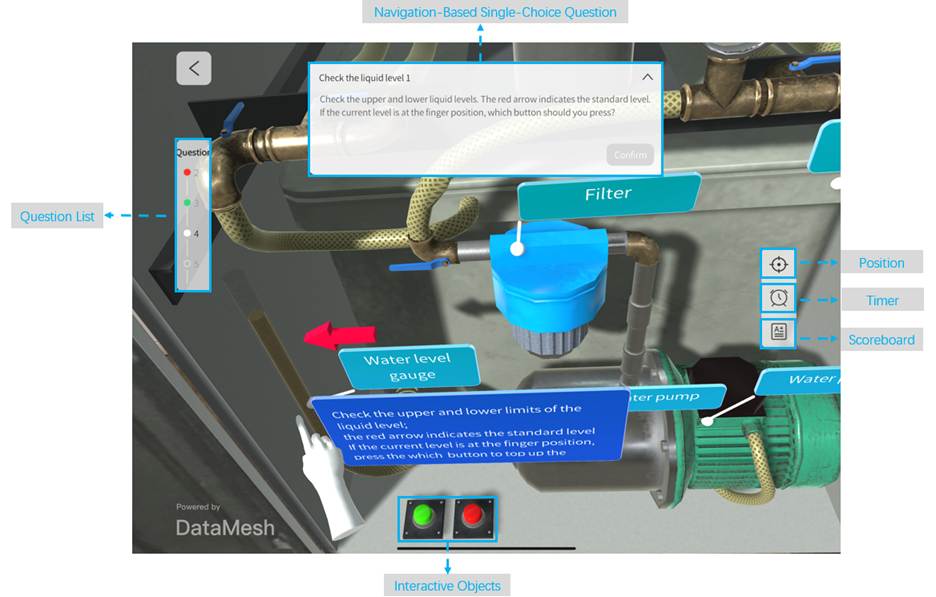
Exam

Answering operations on the interactive page are as follows:
- Select Option: Clicking an interactive object (such as a button or model) is considered selecting the corresponding option and will navigate to the relevant scene. The Confirm button will then be highlighted.
Learning

Exam
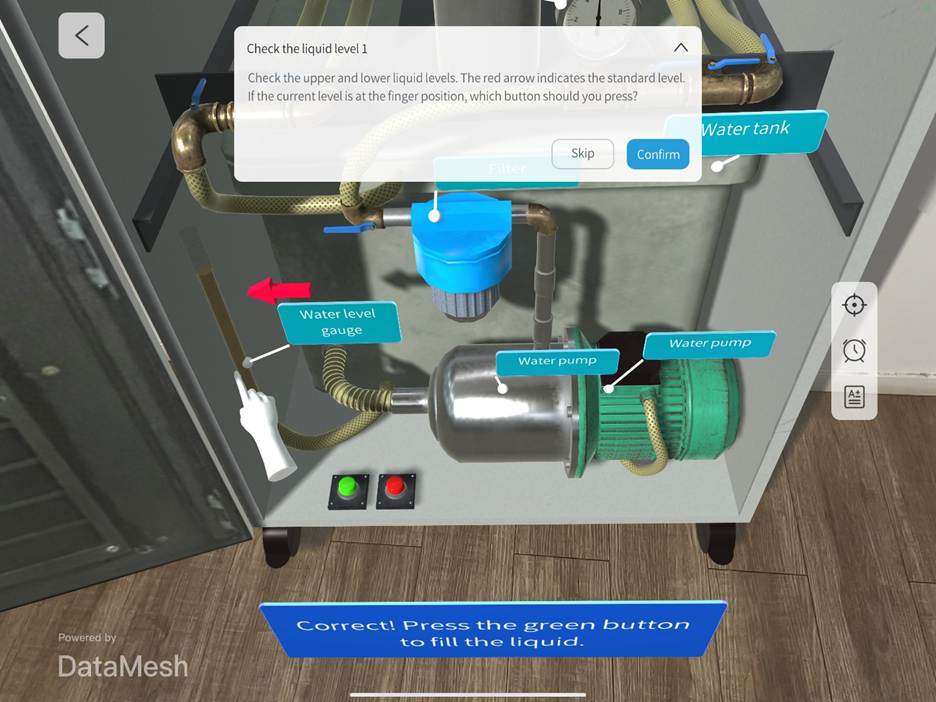
After selecting an interactive object, the following actions are supported:
- Confirm: Click the Confirm button, the system will score the answer based on the selected option’s points, and the score will be displayed in the lower-right corner.
- Skip: Click the Skip button to bypass the current question and proceed to the next one. Skipped questions cannot be revisited and will be marked as incorrect, scoring the minimum possible points.
- Return (Optional): If the courseware has enabled a return feature, users can return to the interactive page and reselect their option. Note: This feature is not built-in for multiple-choice questions. It is implemented during the scenario editing process by setting a transition button in the scene, with the target scene set to the interactive page.
Multiple-choice questions
In a multiple-choice question, all options are displayed directly on the question panel. The user must select all the correct options to earn points. The question panel includes the title, question content, and options, and users can review course material to help understand the question and provide an answer.
Learning
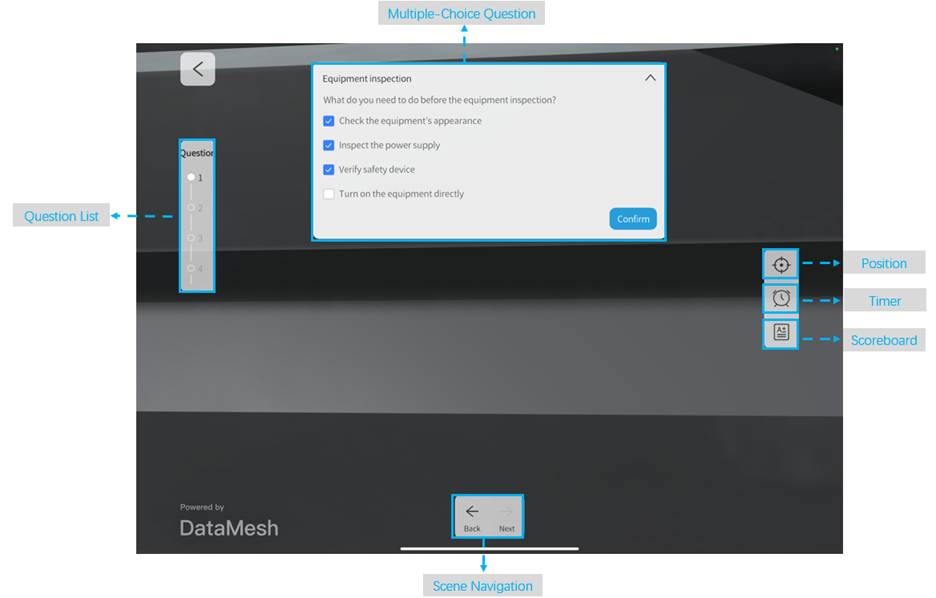
Exam

The answering operations are as follows:
- Confirm: After selecting all the correct option, click the Confirm The system will score the answer based on the selected option’s points, and the score will be displayed in the lower-right corner.
- Skip (Exam): Click the Skip button to bypass the current question and automatically proceed to the next one. Skipped questions cannot be revisited and will be marked as incorrect, scoring the minimum possible points.
- Scene navigation:
- If set to On click, users can use the scene navigation arrows to move between scenes.
- If set to Autoplay after X seconds, the system will automatically navigate after the waiting period, or users can manually navigate by clicking the scene navigation
- If set to Navigate via button or link, the scene navigation arrows will disappear, and users can only navigate by clicking the corresponding interactive object (button or model).
Hands-on questions
Users need to perform position-based operations (such as moving, rotating, etc.) with interactive elements on the hands-on question interface. This hands-on approach helps users better understand and master the knowledge.
Learning
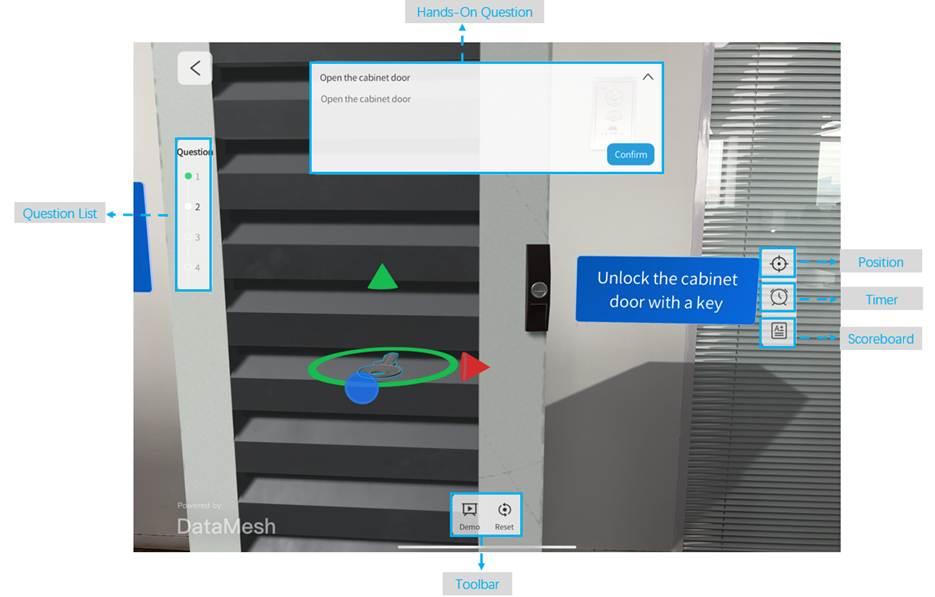
Exam
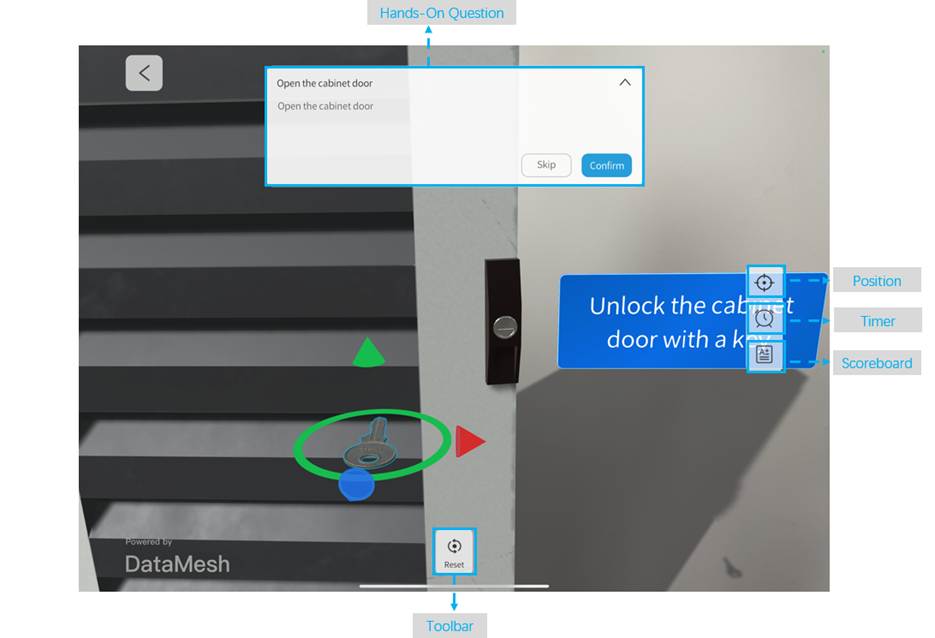
Answering operations are as follows:
- Confirm: Select the interactive object (highlighted in blue), position it correctly, and rotate it to the specified angle. After completing all interactions with the objects, click the Confirm button to finalize the practical task. Note: For multi-step tasks, actions can be performed in any order unless a specific sequence is required. If the question specifies a particular order of operations, follow the steps as instructed to get the correct score points.
- Skip(Exam): Click the Skip button to bypass the current question and automatically proceed to the next one. Skipped questions cannot be revisited and will be marked as incorrect.
- Demo(Learning): Click the Demo button to view the correct interaction method for the character. This option is not available in the exam.
- Reset: Click the Reset button to restore the model to its state before movement.
Answer result
After completing each question, the system will display the result in the bottom-right corner of the page. The panel includes the question name, answer result icon, and score.
- Answer result icon:
 :If the user answers without any mistakes, it will be marked as correct.
:If the user answers without any mistakes, it will be marked as correct. :If there’s an error in any step or an incorrect option is chosen, it will be marked as incorrect.
:If there’s an error in any step or an incorrect option is chosen, it will be marked as incorrect.
- Score: The final score for the question.
- Content Viewing Questions: The system directly determines the score based on the answer result.
- Single-Choice and Multiple-Choice Questions: The system calculates the score based on the options the user selects.
- Hands-On Questions: The system adds up the score for each step of the user’s actions to determine the total score. If there is a required order for the steps, the system will score based on the order of operations: steps in the correct order earn correct scores, while steps in the wrong order earn incorrect scores.
If the question has a time-based score, the final score will be calculated as: (sum of scores for successfully completed steps) * the percentage of time spent within the total allotted time + (sum of scores for failed steps).
When the answer is correct, the interface will look like this:

When the answer is incorrect or the question is skipped, the interface will look like this:

If the question is a key question, the system will display a custom prompt when answered incorrectly or skipped. After clicking Confirm, the system will forcibly exit the current learning session or exam.
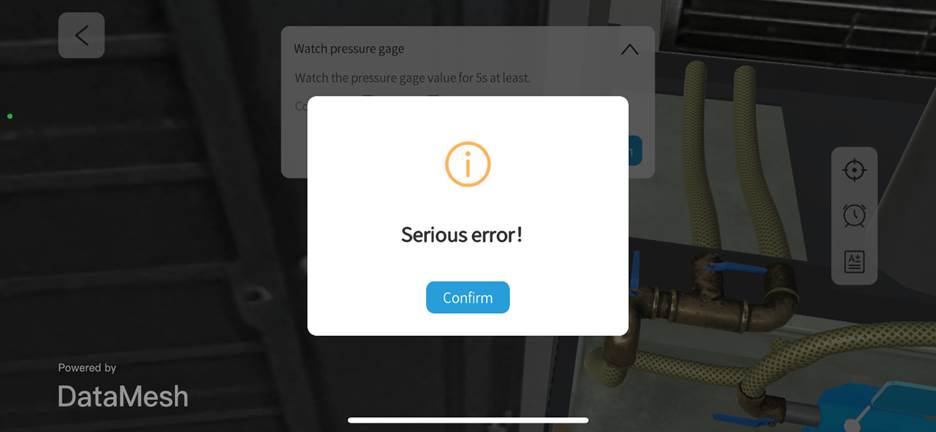
Question list
The question list is available only in learning mode. It allows users to view the current answer status of each question. You can click on the question number or status to re-answer completed questions or to view and answer incomplete questions. This feature provides flexibility to manage your progress and lets you quickly navigate and adjust during your learning.

Question Status:
| Status | Description |
| Question completed, answered incorrectly. | |
| Question completed, answered correctly. | |
| Question in progress, not yet completed. | |
| Question not started or incomplete. |
Answering operations:
- Browse Questions: In the question list panel, you can view the status of all questions. Scroll up or down to browse through the questions.
- Jump between questions: Click on the question number or status in the list to jump directly to that question.
- Jump to Incomplete Question: Click an Incomplete question in the list to go directly to it and answer it.
- Jump to Completed Question: Click a Completed question in the list. A prompt will appear: “Would you like to retry this question?”
- Confirm: The system will reset the question to its initial state, change the status to Incomplete, and take you directly to the next Incomplete question after completing the question.
- Cancel: You will remain on the current question, and its status will remain as Completed.
Record
The Record module comprehensively records the user’s learning and exam performance, helping users understand their learning progress and exam results.

- Avatar: Users can upload a custom avatar on the FactVerse platform.
- User Name: For external users, the name is displayed upon login; for internal users, the username is displayed.
- Learning/Exam Records:
- Time: Displayed in ascending order of completion time; format is yyyy.mm.dd hh:mm, for example, 2022.02.02 12:23.
- Courseware Name: Displays the name of the learning or exam task.
- Time spent: Format is hh:mm:ss.
- Score: Shows the final score for a courseware learning or exam.
- Operation Data Upload Status: After the exam, the upload status of the operation data will be displayed in the Exam Records tab. The Learning Records do not have this option.
- Gray
 : Indicates that the data has not been uploaded. Click the icon to upload the data.
: Indicates that the data has not been uploaded. Click the icon to upload the data. - Red
 : Indicates that the data upload failed.
: Indicates that the data upload failed. - Green
 : Indicates that the data upload was successful.
: Indicates that the data upload was successful.
- Gray
Exam monitoring interface for the teacher
Group list
The group list on the exam monitoring interface displays all training groups within the validity period of this tenant.

In-group student list
The in-group student list displays the status of all students in the exam and offline.
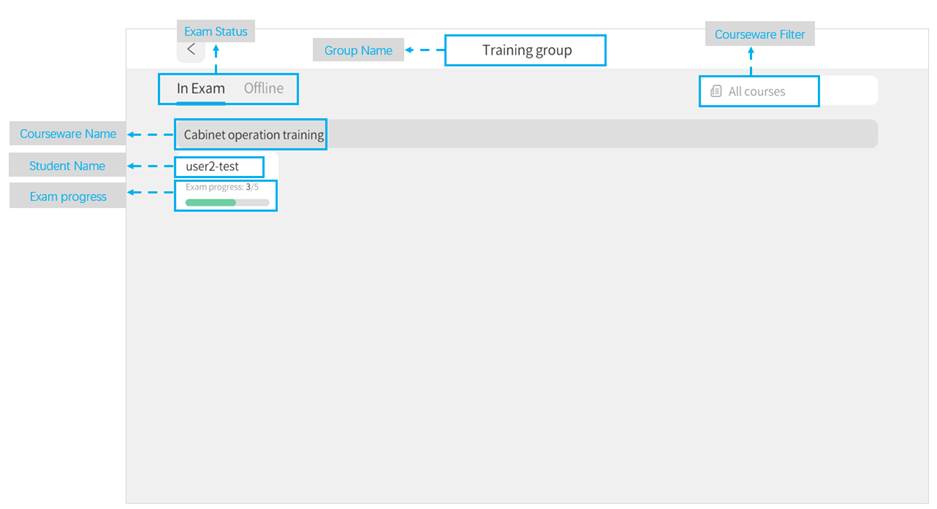
Exam Status: The exam status of each student in the training group. There are two statuses: “In Exam” and “Offline.”
- In Exam:
- Courseware Name: The name of the courseware being examined.
- Student Name: The name of the student currently taking the exam.
- Exam Progress: The student’s progress on the exam.
- Courseware Filter: Click this button to expand the courseware list. Select a course, and it will only display the list of students currently taking the exam for that course.
- Offline:
- Student Name: The name of the offline student.
Exam monitoring interface
The exam monitoring interface allows teachers to view students’ exam statuses from a third-party perspective. Teachers can adjust the view, move, or zoom in on the scene to observe more effectively.

The side buttons on the proctoring page support the following actions:
- Student Switch
 : Click the student switch button to switch to another student’s exam monitoring page.
: Click the student switch button to switch to another student’s exam monitoring page. - Avatar Toggle: Click the button to enable or disable the Avatar. When enabled, the exam monitoring interface will display a virtual avatar representing the student’s location and direction. The virtual avatar will follow the student’s direction when the student’s device camera moves. The Avatar will be enabled by default if the student’s device is in MR mode.
- Timer
 : If the courseware has no time limit, the timer is not displayed. If a time limit is set, click the timer button to display the remaining time until the exam ends. If the time exceeds the limit, the exam will automatically end.
: If the courseware has no time limit, the timer is not displayed. If a time limit is set, click the timer button to display the remaining time until the exam ends. If the time exceeds the limit, the exam will automatically end. - Scoreboard
 : Click the scoreboard button to view real-time scores.
: Click the scoreboard button to view real-time scores.
Courseware Learning
This section walks learners through the full process of using Training Mode in DataMesh One to study courseware and answer different types of questions.
Steps to Start Learning
Step 1: Log in to Training Mode
Learners log in to DataMesh One and select Training Mode to begin.
Step 2: Select Training Group and Launch Courseware
1. Go to the Learning tab and select your assigned training group.

2. From the group’s courseware list, click on the courseware to open it.
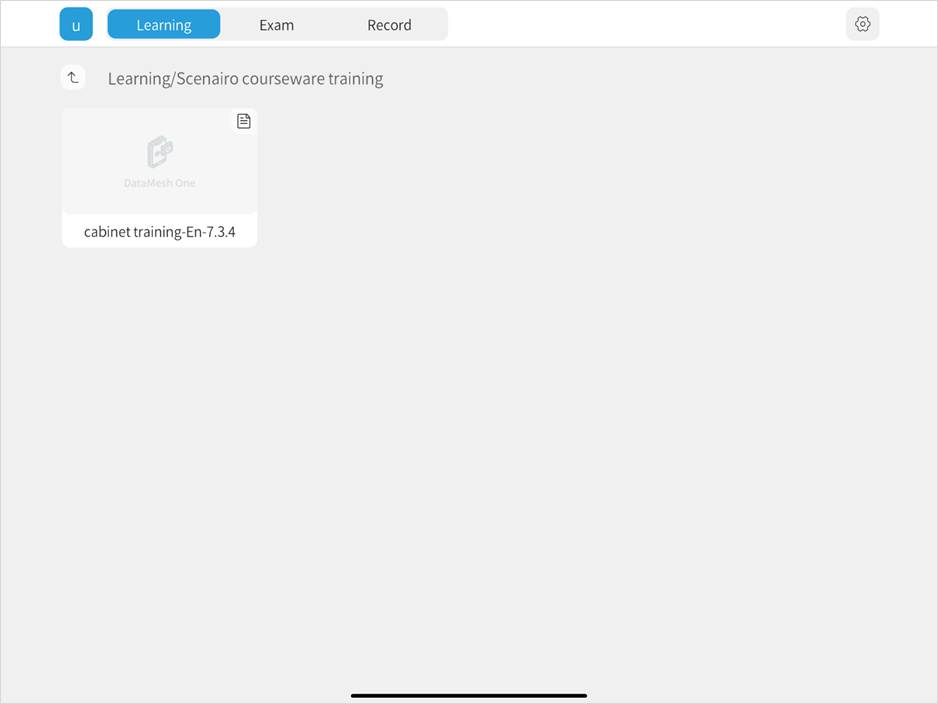
3. Once opened, complete the scene positioning as prompted.
- If repositioning is needed, use the Positioning button. For details, refer to the Standard Mode | Resource Positioning section.
- Note: If the courseware has predefined headset view or operation panel position in Studio, One will apply those settings automatically. Learners cannot adjust them in One, ensuring the intended viewing angle and panel layout. For details, see the DataMesh Studio User Manual.
Error tip: If a message says “Score allocation mismatch,” you can choose Continue or Cancel. It’s recommended to notify the instructor to revise the settings before proceeding.
Step 3: Start Answering Questions
Once the courseware is loaded, learners can follow the question sequence or freely select questions from the list.
Available features during the session:
- Jump to questions: Click on any item in the question list to revisit or review.

- View scores: Click Scoreboard
 to check your real-time score.
to check your real-time score.
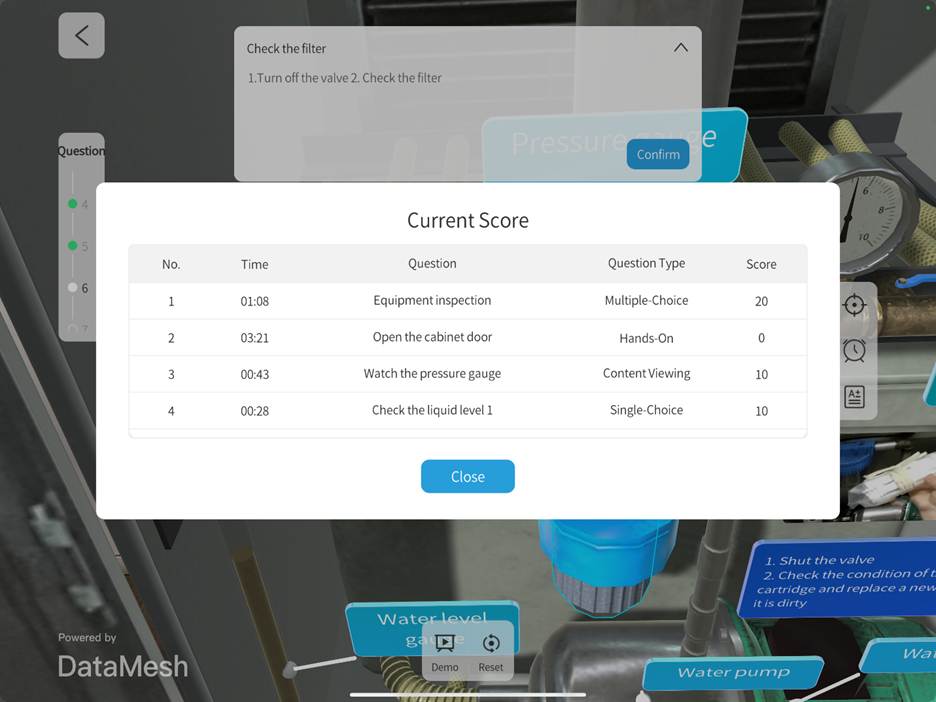
- Check remaining time: Click Timer
 to see how much time is left.
to see how much time is left.
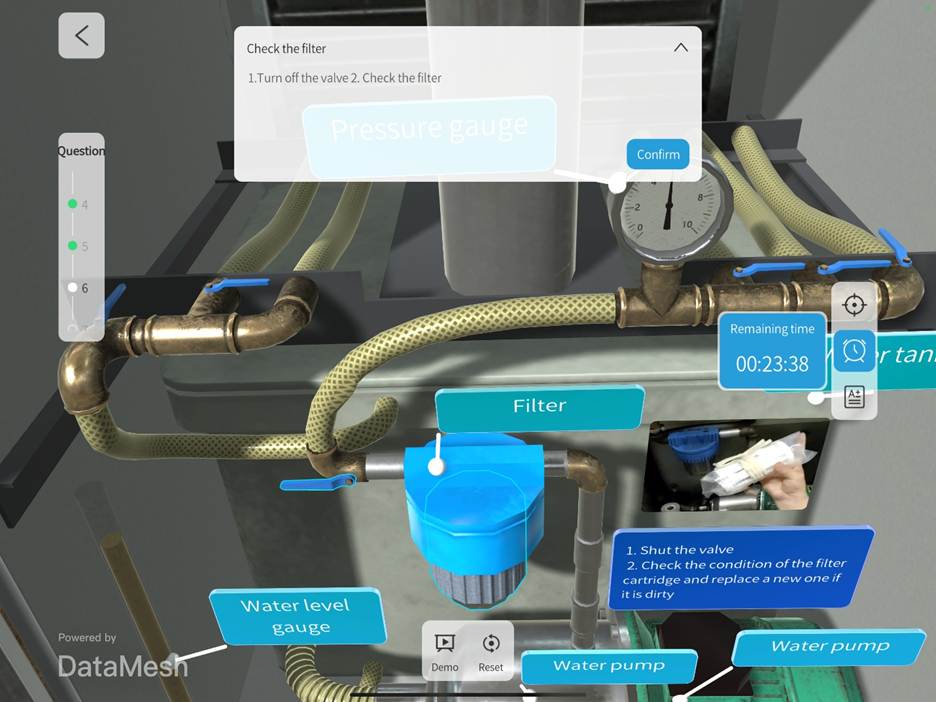
Step 4: Complete and Review Results
After completing all questions:
1. The system will indicate that the session has ended.
2. Click View Scores to see your score.
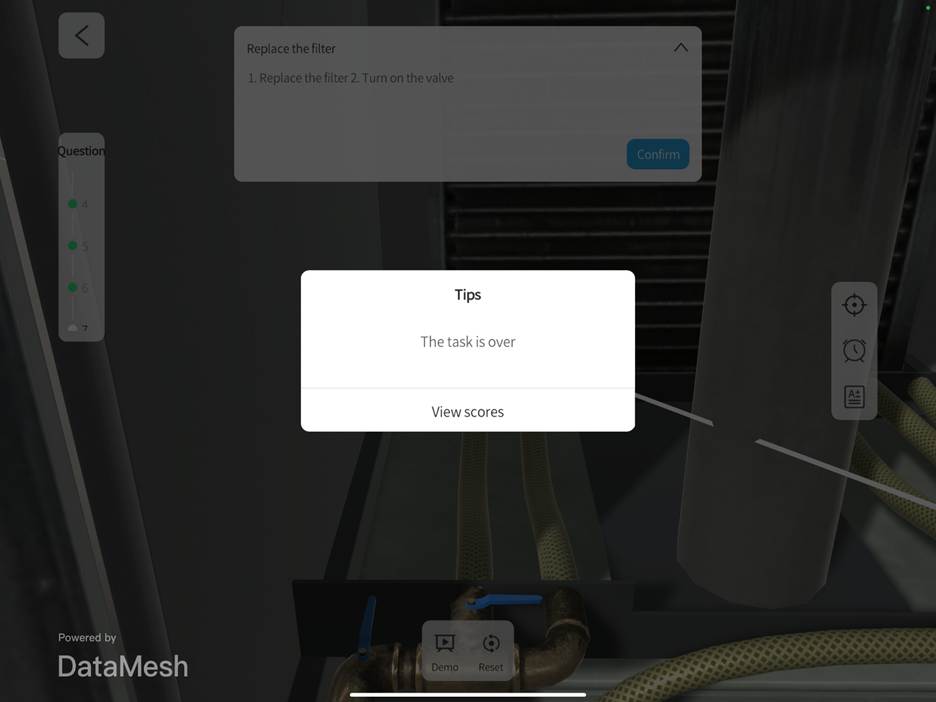
3. Click Confirm to finish the training.

Question Types
DataMesh One supports multiple types of questions in courseware. Each question type has a slightly different interaction method. Below is an overview of each type:
Content Viewing Questions
How it works:
Follow the instructions to view provided content such as images, videos, PDFs, or script pages. This may involve flipping pages, clicking buttons, or opening links. Once the timer ends, click Confirm to complete the question.
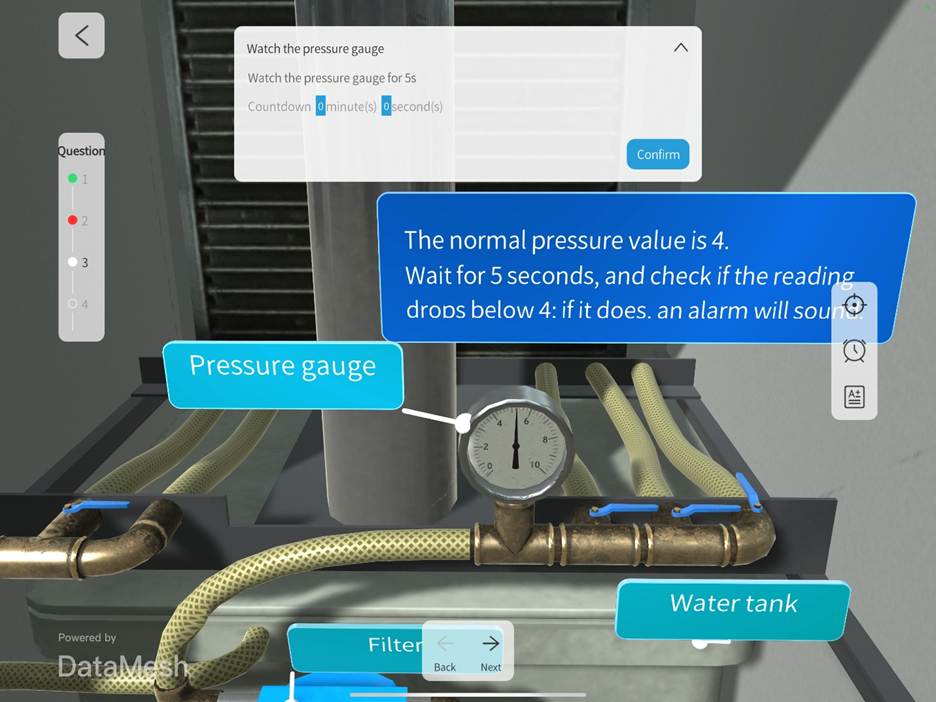
Single Choice Questions
Standard Type:
Select one option from the list and click Confirm to submit your answer.
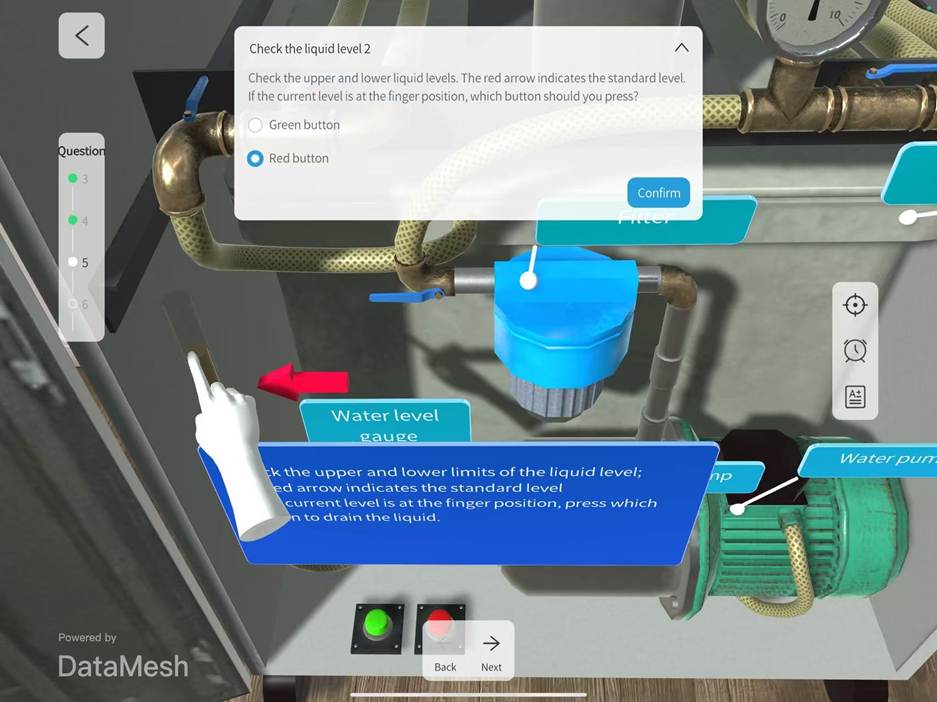
Interactive Type:
Some questions are designed as interactive choices. Click the object in the scene to navigate to a new page, then click Confirm to submit. If the courseware includes a return mechanism, you can go back to make another selection.
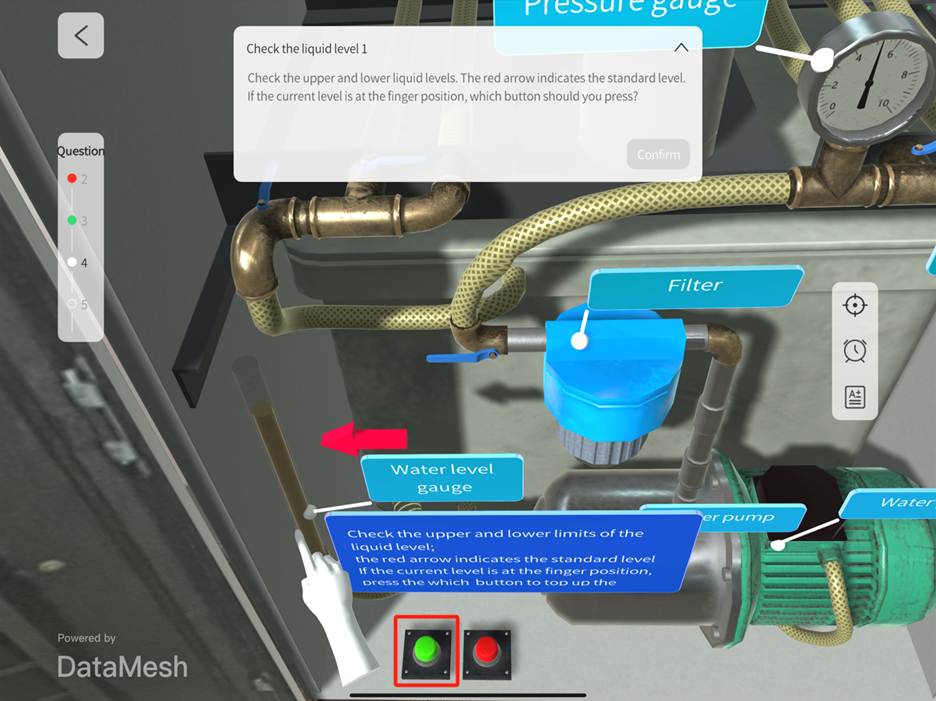
Multiple Choice Questions
How to answer:
Select all the correct answers based on the question. Click Confirm to submit.
⚠️ Note: Selecting too few or too many options may lower your score—please review carefully before submitting.
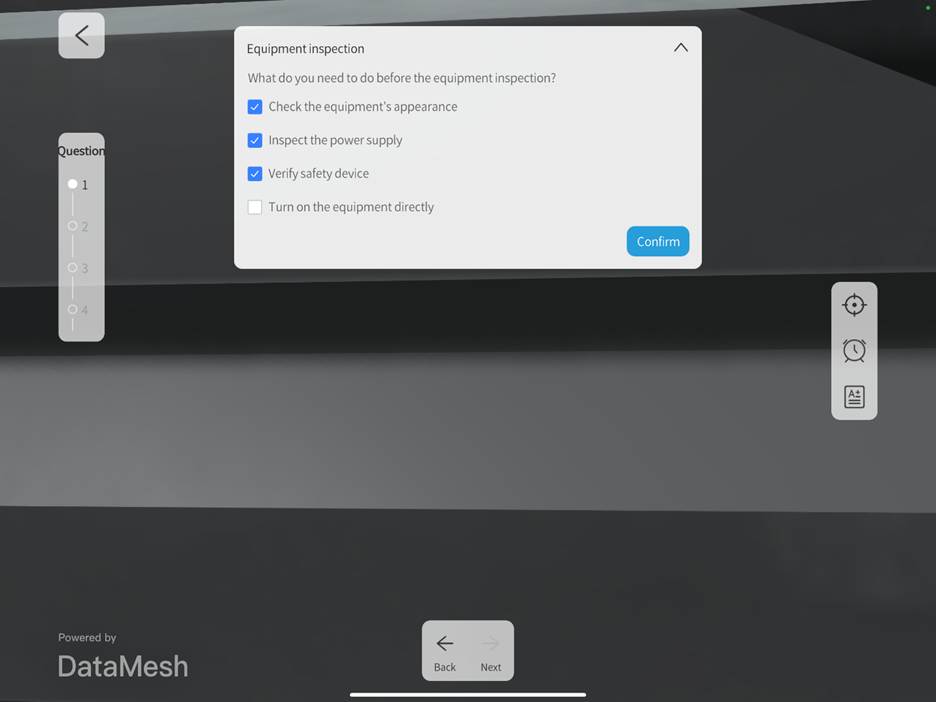
Hands-On Questions
Hands-on questions assess learners’ ability to interact with models in the scene.
How to complete:
1. Click Demo to view the standard operation.
2. Select the interactive object (objects that can be operated will be highlighted in blue).

3. Move, rotate, or grab the model as instructed. When it reaches the correct position, it will flash to indicate it’s locked in place.
- If the operation is incorrect, click Reset to return the model to its initial position and try again.
4. After completing all required steps in the scene, click Confirm to submit.
Scoring Overview
- Position Score: Based on whether the model is within the target location and rotation tolerance. If offset ranges are configured, partial credit is given accordingly.
- Hand/Grab Score: If a specific hand or grab point is required, these are scored separately.
- Sequence Score: If a step order is required, actions must follow that order to receive credit—otherwise, position scores for out-of-order steps will be marked as failed.
⚠️ Final score per step = Position score (including offset and order) + Hand score + Grab score (including offset).
For detailed scoring logic, refer to the “Scoring Mechanism” section in the DataMesh Studio User Manual.
Course Assessment
Steps to Begin
Step 1: Log in to Training Mode
Learners log into DataMesh One and select Training Mode from the main menu.
Step 2: Select Training Group and Launch Courseware
- Go to the Exam tab and select your assigned training group.
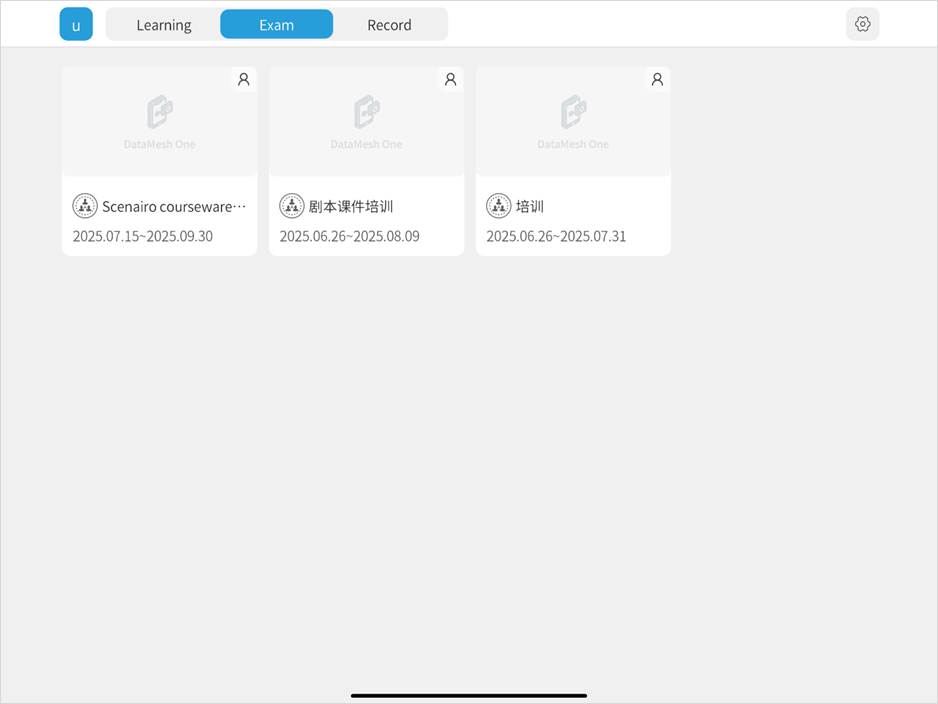
- From the group’s courseware list, click on the target course to begin.

- After launching the course, complete script positioning.
- If repositioning is needed, use the Positioning button
- For details, refer to Standard Mode | Resource Positioning in the Standard Mode section.
Note: If a “Score allocation mismatch” prompt appears, you may choose Continue or Cancel—however, it is recommended to contact your instructor for confirmation before proceeding with the exam.
Step 3: Start Answering
In Exam Mode, questions must be answered in the preset order—you cannot skip or jump between them.
During the exam, you can use the following optional tools:
- View Score: Click the Scoreboard icon
 to check your current score.
to check your current score.
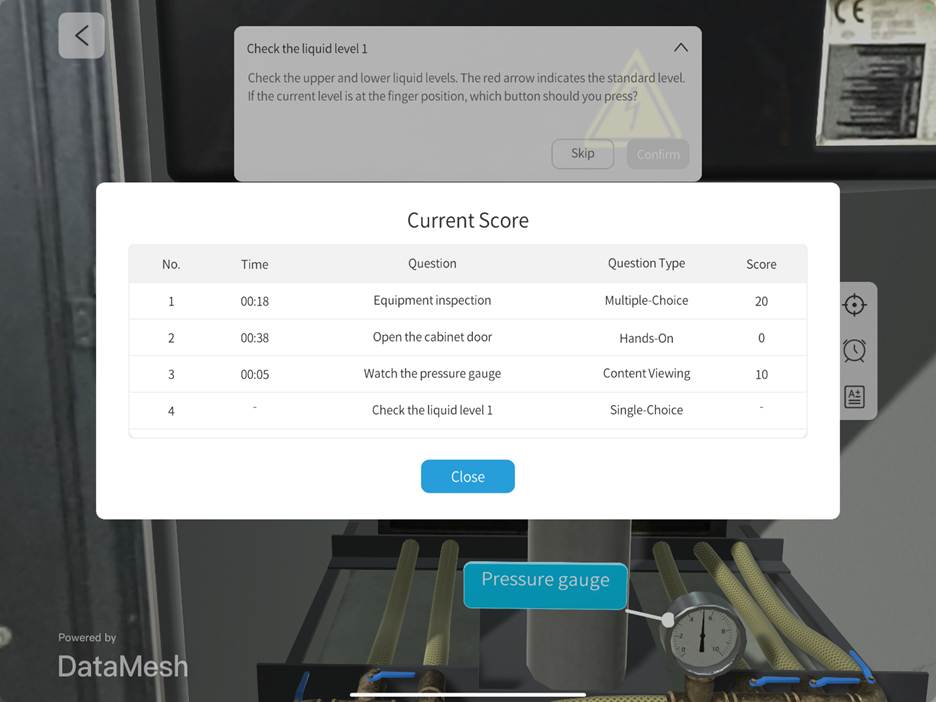
- View Remaining Time: Click the Timer icon
 to see how much time is left.
to see how much time is left.
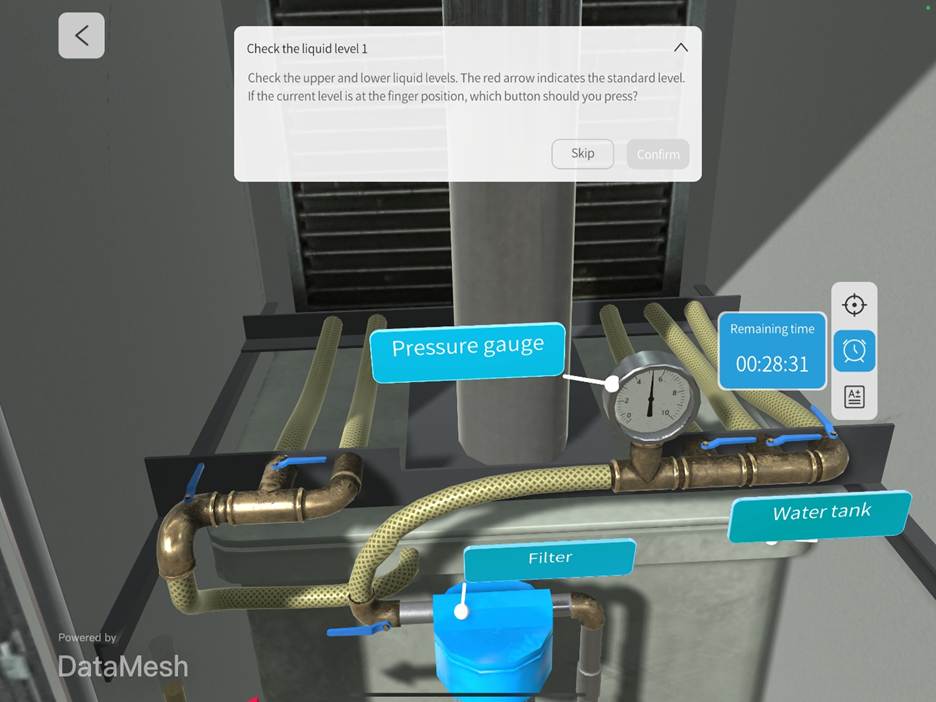
Step 4: Finish and Review Your Exam Result
- Once all questions are completed, a “Task Completed” message will appear.
- Click View Exam Result to see whether you passed.
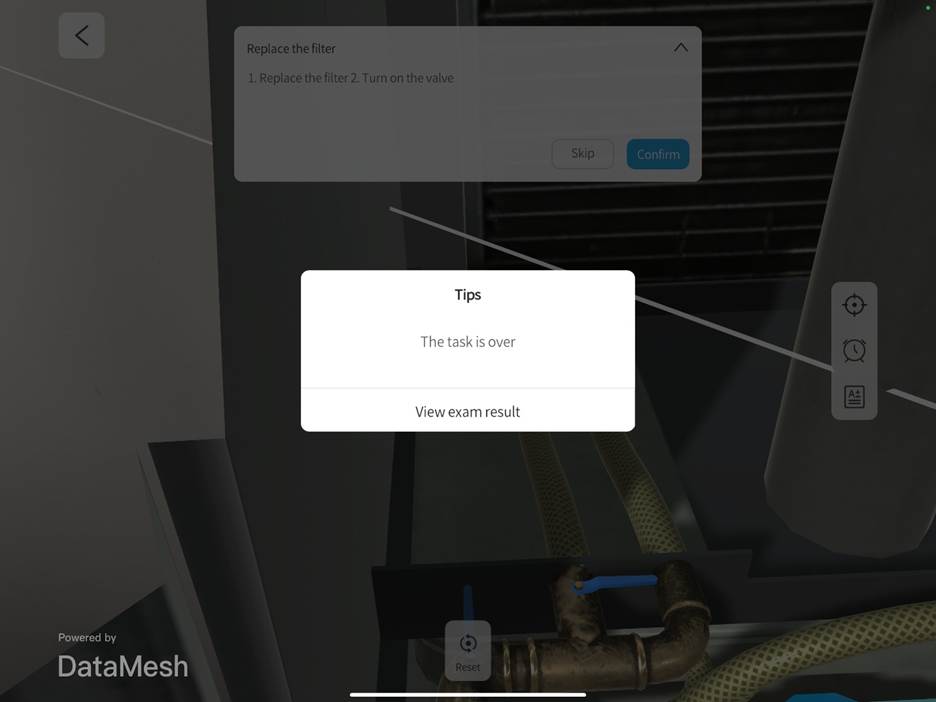
- Click View Scores to check your detailed breakdown and final score.
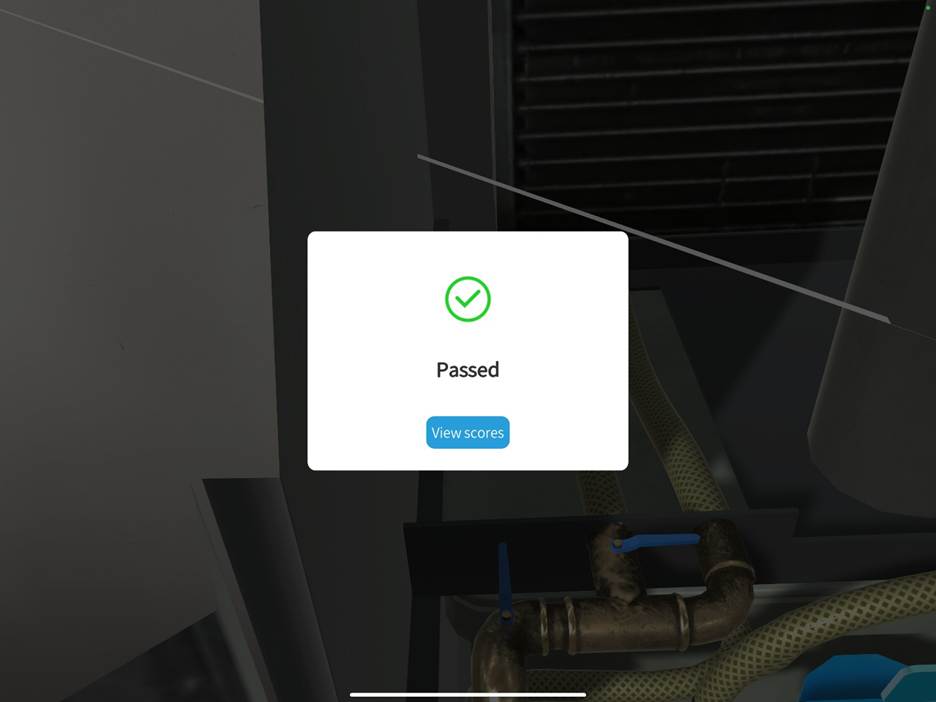
- Click Confirm to finish the exam.

Step 5: Upload Exam Operation Data
After the exam ends, a prompt will ask whether to upload your operation data:
- Click Confirm to upload the data immediately.
- Click Cancel to upload later. If you skip the upload, you can go to the Exam Records tab in Career Tracking to submit it manually.
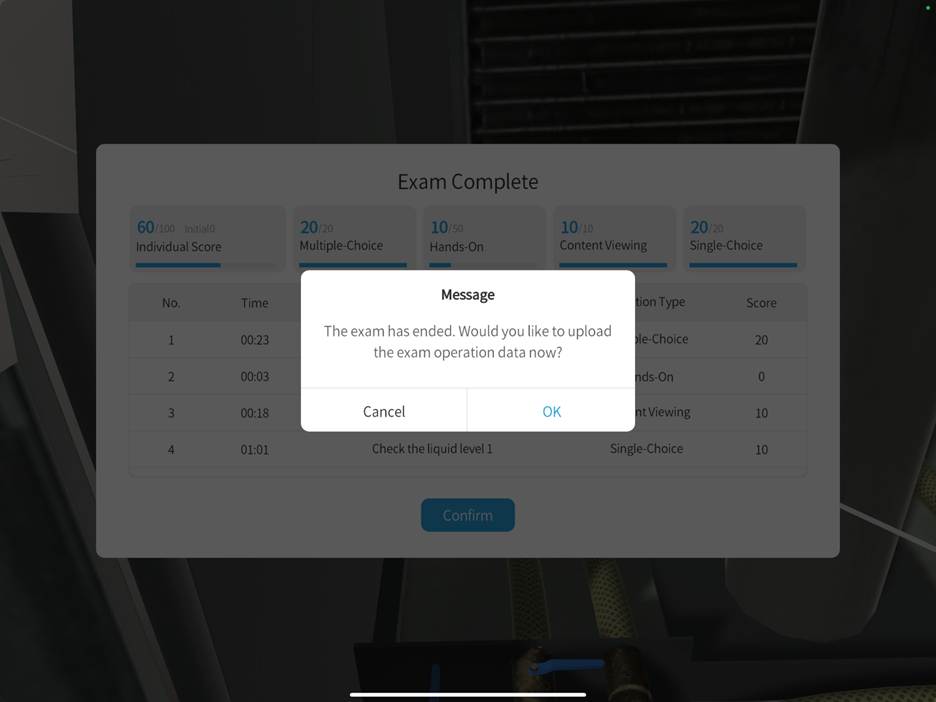
Question Types in Exam Mode
DataMesh One’s Exam Mode supports the following question types:
- Content Review
-
- Follow the prompt to view images, videos, PDFs, or scripts by flipping pages or clicking links.
- Once the countdown ends, click Confirm to complete the task.
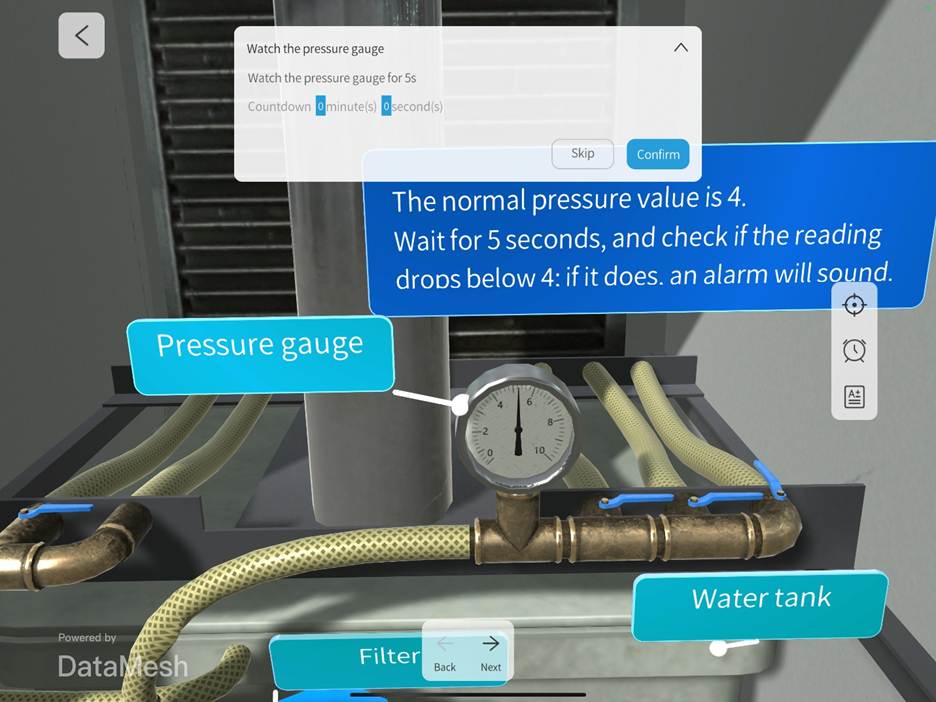
- Single Choice
-
- Read the question and select one correct answer in the panel, then click Confirm to submit.
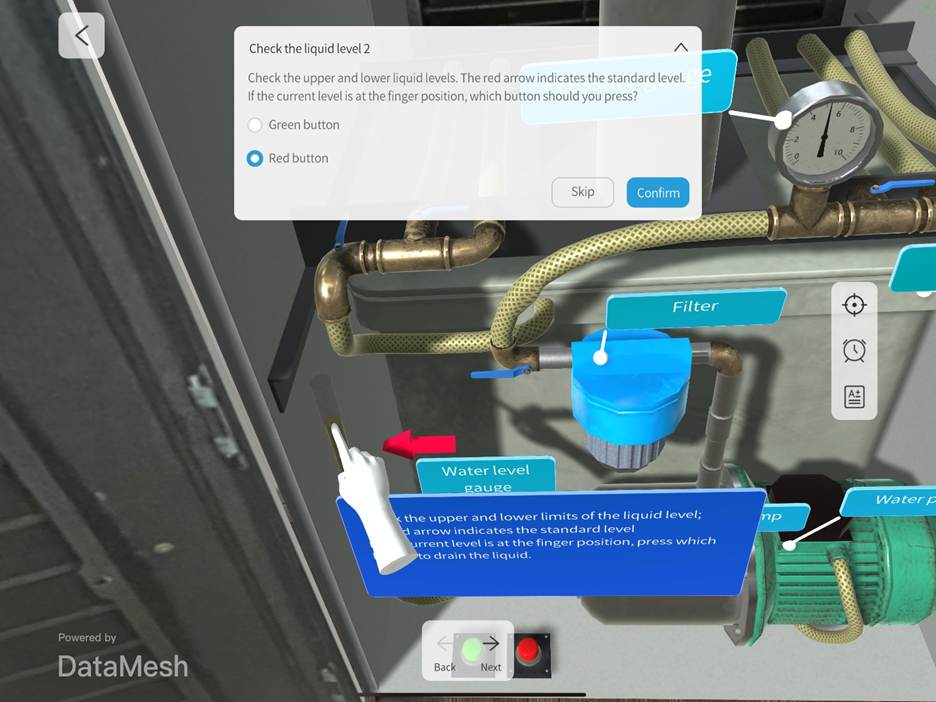
- Interactive Single Choice
-
- Click the interactive object required by the question to navigate to a target scene or page.
- Click Confirm to submit. If the course supports it, you may go back and change your answer.

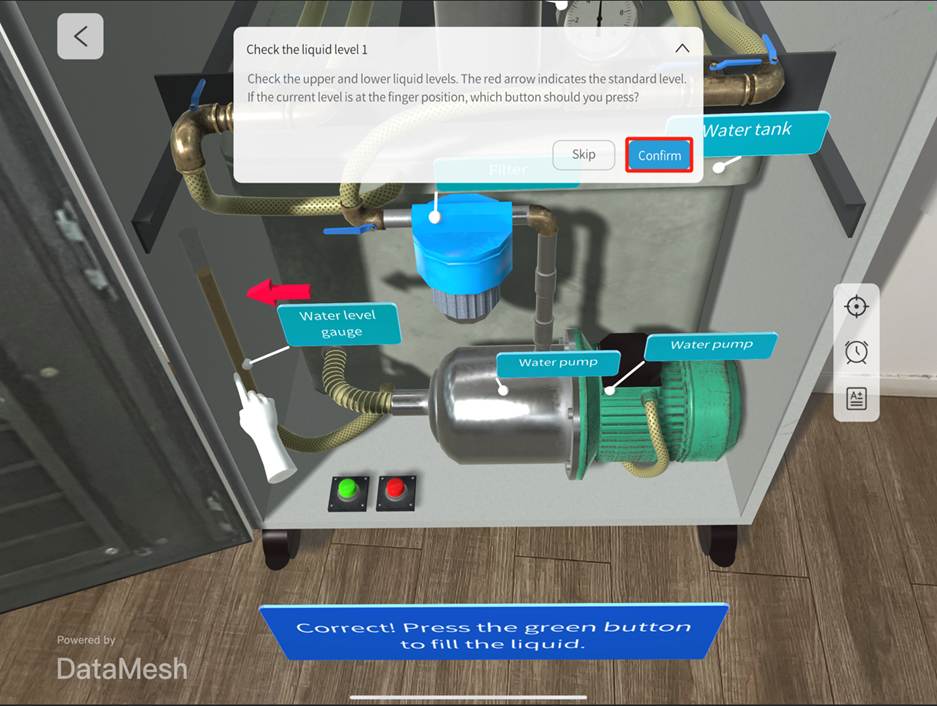
- Multiple Choice
-
- Select all correct answers as prompted and click Confirm.
- ⚠️ Partial selection or extra selections will affect your score.
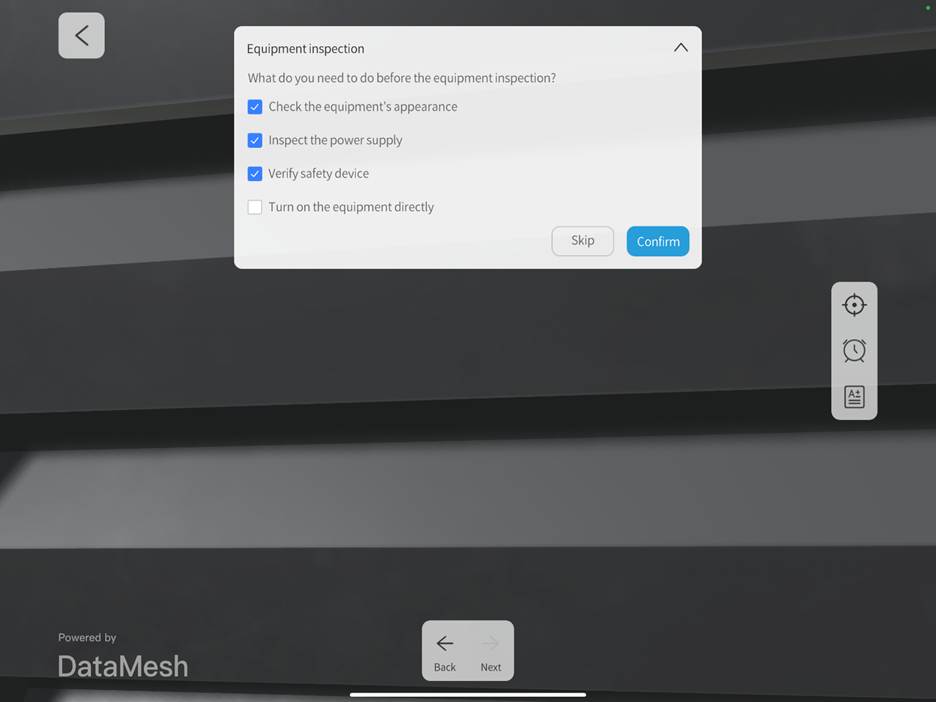
- Practical Task
Demonstrates hands-on skills by manipulating 3D models in the scene. No demo playback is available in Exam Mode.
How it works:
1. Select the interactive object (highlighted in blue).
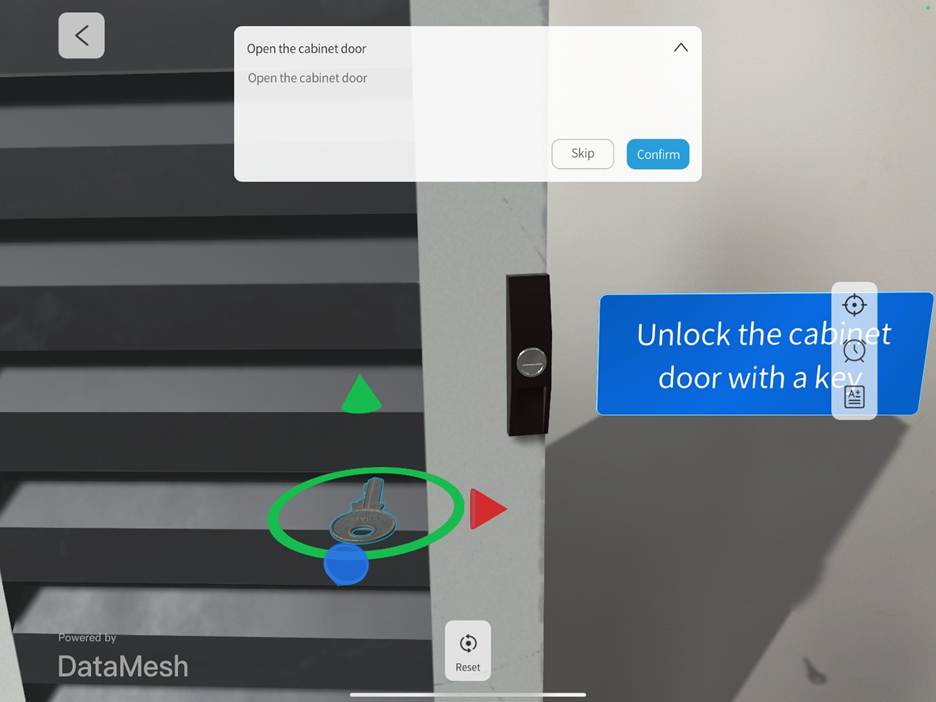
2. Move or rotate it to the required position—when correct, it flashes twice to indicate it’s locked in.
3. If incorrect, click Reset to try again.
4. Once all required actions are complete, click Confirm to submit.
Scoring breakdown:
- Position Score: Based on proximity to target position and orientation; partial credit applies if offset scoring is enabled.
- Hand / Grasp Score: If specific hand type or grasp area is set, these are scored separately.
- Order Score: If sequence matters, steps must be done in the right order or the position score will fail.
🧠 Final score per step = Position Score (with offsets + order check) + Hand Score + Grasp Score (with offsets)
For full scoring logic, refer to “Scoring Mechanism“ in the DataMesh Studio User Manual.
Teacher proctoring
Step 1: Log in to Training Mode
The instructor logs into DataMesh One and selects Training Mode.
Step 2: Select Training Group
Go to the Proctoring tab and choose the relevant training group.

Step 3: Monitor Student Exam Status
Once inside the group, you can view the exam status of all students, including:
- Which students are currently taking exams and their assigned courses
- Exam progress of each student
- Offline students (displayed by name)

Step 4: View Individual Student Activity
1. Click on a student who is mid-exam to enter third-person view of their session.

2. Enable the Avatar to see the student’s location and orientation—helpful for assessing engagement and behavior.
3. Use the Timer icon![]() to check remaining time, and Scoreboard icon
to check remaining time, and Scoreboard icon![]() to review current scores.
to review current scores.
4. Use the Student Switch icon ![]() to quickly jump between different students’ exam sessions.
to quickly jump between different students’ exam sessions.